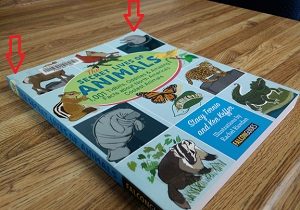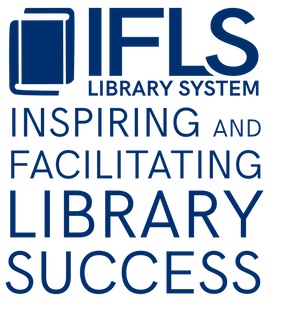Physical Parts Labeling, Ownership Labeling, and Packaging Policy
Approved by MORE Directors Council, May 2024
Barcodes must be placed horizontally on the front cover in the upper left quadrant for all materials [pictured]. This must be true for all items added to the collection on or after June 17, 2024

Multipart items must have all parts listed on a label placed directly under the library’s barcode. For libraries who choose not to add this label, they may not charge other libraries or other libraries’ customers for missing parts. Examples of labels include:
- 11 discs
- 12 discs and 1 booklet
- Map inside back cover
- 2 cases, 10 discs
Label templates (editable DOCX files): DVD and Blu-Ray | 2 discs | 2 discs + booklet | 3-4 discs | 3 discs + booklet
Separate parts should be labeled with the owning library’s name. Labeling parts with the barcode number is a best practice.


If there are any special return instructions for the customer, a label with these instructions must be attached to the item.

If an item is damaged but the owning library has determined that it should still circulate, the damage should be noted inside the front cover where it can be easily found and read.


Packaging
All items should be circulation-ready and suitable for:
- Normal wear-and-tear associated with multiple individual users
- Travel via courier in bins with all types of other materials (more about courier)
- Being sorted, shelved, and found in multiple locations
Some items are able to circulate as is. However, many items require additional packaging to make them suitable for library use. Best practices for processing items are as follows:
- Replace cardboard A/V cases with solid plastic cases

- Replace recycled cut-out plastic cases with solid plastic cases. If you are in need of solid plastic dvd cases, contact IFLS / submit a help desk ticket.

- Use plastic dust jacket covers.
- Reinforce paperback spines and edges. This can be done with full book covers or book tape


For libraries who choose not to add the library packaging listed above, they may not charge other libraries or other libraries’ customers for damage to these items resulting from failure to adhere to the packaging guidelines.
Multidisc items added to the collection on or after February 1, 2008 must circulate together as a set.
Authority vendor information – Backstage Library Works.
The IFLS Library system utilizes Backstage Library Works as an authority control vendor. In addition to providing new and updated authority records each month, Backstage Library Works provides bibliographic record enhancement and RDA conversions in the form of title statements, imprint information, physical description, authorized access points, and the addition of reading notes in the form of Accelerated Reader and Lexile Framework for Reading.
You can view the current Authority Control Profile here: IFLS Backstage Library Works profile 11/2024.
For further explanation of the profile, please see the corresponding Authority Control Profile Guide: Backstage Library Works profile guide
On the first Friday of each month, MORE staff compile a list of bibliographic records to send to Marcive in order to provide the following services:
- Overnight Authorities ……….. authority control for new bibliographic records
- Notification Service ………….. ongoing authority file maintenance
- NewMatch ………………………. finding new authorities for previously unmatched access points
- RDACS ……………………………… Resource & Description Access Conversion Service
MORE staff will sent out email alerts regarding the sending of files to Marcive and any other information to the following MORE email lists:
- Morebib – MORE Bibliographic Records and Standards Committee members
- Morecat – Cataloging Partners and MORE Cataloging staff
Need help answering specific questions or finding additional resources?
Click on the green HelpDesk button and we’ll make sure the right IFLS staff gets that message right away. Can’t find the green button? Use this email: helpdesk@ifls.lib.wi.us.
There’s no wrong door at IFLS!
Welcome to the IFLS Library System: 2024 video
Labeling & Rating Systems
On This Page
Frequently asked questions
What is the current situation?
What about directional labels?
How can I help patrons find materials?
Why shouldn’t we label materials with certain content?
Additional Resources
Can’t find what you’re looking for here? Use this search box to search the IFLS Article Index.
Additional Support from IFLS
Click on the green HelpDesk button and we’ll make sure the right IFLS staff gets that message right away. Can’t find the green button? Use this email: helpdesk@ifls.lib.wi.us.
What is the current situation nationally and locally with labeling?
Librarians use professional judgement and expertise to select, catalog and classify, place and promote materials to make sure that people can find what they want and need. Sometimes a label can help people more easily find what they are looking for, and sometimes labels can either intentionally or unintentionally restrict use.
Right now, there is an increase in organized scrutiny of library collections. These efforts are aimed at limiting access to materials, or in other words, censorship. Rating systems like BookLooks, created by Moms for Liberty members, are being promoted by groups and individuals as a way to restrict access. Some groups or individuals demand that libraries label materials, but this act can restrict access to materials, one of the ways materials are censored.
According to the ALA Freedom to Read Statement: “It is not in the public interest to force a reader to accept the prejudgment of a label characterizing any expression or its author as subversive or dangerous. …labeling presupposes the existence of individuals or groups with wisdom to determine by authority what is good or bad for others. It presupposes that individuals must be directed in making up their minds about the ideas they examine. But Americans do not need others to do their thinking for them.”
In short: When considering whether to add a label to an item in the collection, librarians should carefully weigh the way-finding benefits with possible negative consequences of applying the label.
How can labels or rating systems restrict use?
- Rating systems are privately developed using subjective and changing criteria and predispose people’s opinions about the materials when labels with rating system information are placed on library materials.
- This includes movie, game, and music ratings
- It also includes tools like BookLooks, created by members of Moms for Liberty and CommonSense Media’s ratings, to name a few.
- Rating systems can be a slippery slope to specifically restricting access to materials for certain ages and groups of people.
- Labels can be prejudicial or be viewed as prejudicial or as a warning, thus restricting access to materials by
- Negatively predisposing people’s opinions about materials
- Creating concerns that being seen with labeled materials will lead to judgement or harassment from others
What about directional labels that are designed to help people find what they are looking for?
It can sometimes be hard to tell whether a directional label could also be a prejudicial label, and there is some room for difference of opinion here.
- Many libraries use genre labels for fiction collections or in classifying picture book collections by broad subject.
- Most of these labels are considered viewpoint-neutral labels.
- Some labels are not really genre labels. “Diverse Books” or “LGBTQ+” are examples of labels that could be seen as a judgement or notice on the content.
- Some libraries, at the request of parents or school partners, have labeled books with Lexile labels or Accelerated Reader labels.
- Some point out that these labels restrict students from choosing books that are not within their assigned levels, and can also create tension for students reading below grade level.
- For others, it is worth the potential for judgment because this is seen as an educational tool that was specifically requested by partners, parents, and children to ensure that they can find the books that they need and want.
How can I help my patrons find materials that will be a good fit for them without labels?
- Reviews on the catalog–be sure to include as wide a range of reviews as possible
- One-on-one reader/viewer advisory services
- You can let library patrons know that there are independent rating services and show them how to access them as needed
Why shouldn’t we label materials with information about whether materials have violent or sexual content or content about sexuality and gender?
- This may restrict access (see above).
- There are people with varying attitudes, opinions, and experiences in every community. Therefore, making a judgment about what constitutes violence or sexual content for everyone is impossible. Is saying mean things violence? Is holding hands or kissing sexual content?
Additional Resources
Recognizing Both Active and Passive Censorship Practices by Dr. Emily Knox
Labeling and Rating Systems Q and A from the American Library Association
When Is a Book Ban Not a Book Ban: The Rebrand of a National Pastime by Kelly Jensen
Contents:
Rethinking Registration webinar
YS Check-in Follow-up
Book Give Away
TeachingBooks for Libraries
CCBC Choices
Share Your STEM Awesomeness
Rethinking Registration webinar
Wednesday, March 20, 10-10:30 am Register
Do you spend a lot of time creating and maintaining spreadsheets for registration? Does staff spend extra time finding and checking names on registration forms? Do you find yourself wondering why you are collecting names, phone numbers and other information? Do you even use that data? In an attempt to make her job and her co-workers’ jobs easier, Kathy Larson (River Falls Public Library) has completely gotten rid of spreadsheets that track Summer Reading Registration and 1000 Books before Kindergarten Registration. If you are interested in ways to continue to count the numbers but are sick of spreadsheets this webinar is for you, and just in time for summer program planning!
YS Check-in Follow-up
For those of you who couldn’t join us for today’s discussion on encouraging reading/engagement during the summer, here are some tips and ideas from participants.
Book Give-away
U.S. Cellular has donated over 300 paperback copies of Green Bay Packer running back A.J.Dillon’s picturebook Quadzilla Finds His Footing to Wisconsin public libraries. Not quite enough for all the libraries in the state. IFLS has 30 copies to give away to libraries in our system. Are you interested in adding this to your collection or using it as a prize? Please let me know if you would like a copy. We’ll send out as many as we can, while supplies last. First come, first served.
TeachingBooks for Libraries
There are so many great resources on TeachingBooks for Libraries, part of BadgerLink, to help you plan programs, displays, and readers’ advisory! If you haven’t explored it yet, check out these training opportunities:
- You can find recorded webinars on the BadgerLink Training Page
- Dive a little deeper on the list-making functions of TeachingBooks in the recorded webinar from IFLS
- Sign up for an upcoming session about Planning Public Library Programs with TeachingBooks on March 19 at 12:00.
CCBC Choices
CCBC Choices 2024, recommending 238 books published in 2023 for children and teens from birth through high school age, is now available!
CCBC Choices 2024 is a digital publication. Entries for each book include full bibliographic citation, annotation, age recommendation and cover image, and a link to the book’s entry in the CCBC-Recommended Book Search database, where custom lists can be created. The publication also includes an introductory essay and name/title index. A citation list (bibliographic information only) of CCBC Choices 2024 is also available on our websitRee.
To hear more from the Cooperative Children’s Book Center librarians, mark your calendar for May 15 and 16, when CCBC librarians will be in Eau Claire with books to examine for yourself and two workshops. More details coming in the next month.
Share Your STEM Awesomeness
From the Wisconsin Afterschool Network: The Wisconsin Afterschool Network is a statewide organization which works to support after school and summer programs and their staff in delivering high quality programming. One of the goals of the Wisconsin Afterschool Network is to empower educators who work with youth to lead engaging STEM activities. Organizations like yours (businesses, museums, libraries, STEM centers) are important resources for these educators. We want to learn about the work you do and how we can help you connect with Out-of-School Time programs in your area. Our hope is to develop a directory and map of STEM organizations in Wisconsin for educators to access on our website as a resource in their community.
We would appreciate you taking a few minutes to complete this survey to help us in our endeavor. Please consider sharing this survey as well with other organizations that serve educators and youth. If you represent a statewide organization, please include statewide resources, but also share with local organizations in your network who offer resources and services to educators.
Survey Link: https://docs.google.com/forms/d/e/1FAIpQLSf91_Xon7pC0hxbtN_2q0IipbxxVrrzDWLCslAekF_hhnfbMQ/viewform
